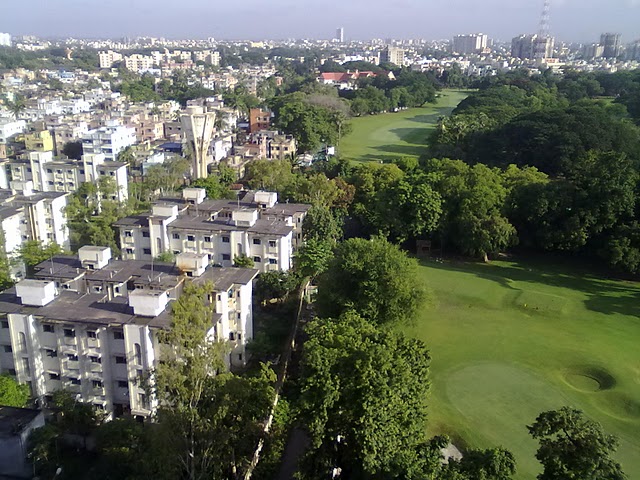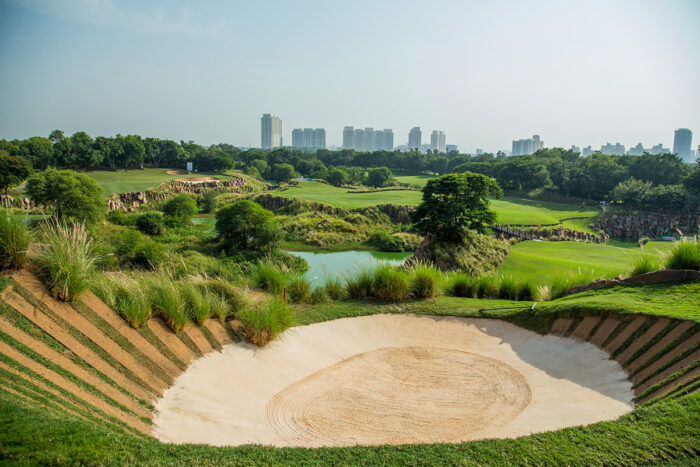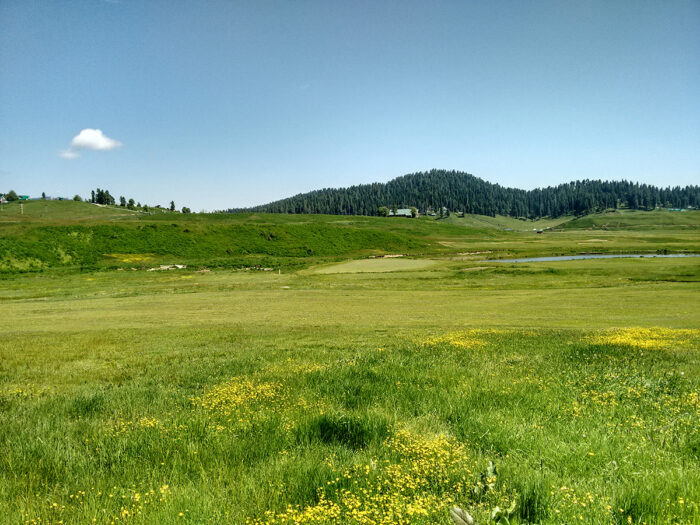A history of the British-India golf links
The history of golf courses in India is probably longer and more interesting than you might think, writes Kiran Kanwar PhD, resulting in some of the most stunning and fascinating courses in Asia.
Every golfer naturally thinks of ‘links’ as referring to a golf course laid out on coastal sand dunes with gusting breezes and a natural, tree- and water-hazard-free layout. In this case, however, the word is used to refer to connections.
How many golfers in India would indeed be golfers if not for the grand old golf courses laid out in the country during the British Raj (rule)? While several new golf courses have popped up all over the country since Indian Independence in 1947, the grandest and best of them are still from a royal and bygone era of long ago. They make for a fascinating study, especially as golf and history are so closely intertwined.
India’s golf courses can be broadly divided into those in the big, crowded metropolises and those in the beautiful hill stations where the weather is always conducive to that found ‘back home’. For the former, it seems like a miracle that any open space could be possible within the teeming millions of humans crowded into small apartments in high-rise buildings or in the neighbouring slums.
The hill station courses were built for those people who managed the local tea or coffee estates, and led a comfortable lifestyle with a great social life that included golf, tennis and a generally active club life.

The Delhi Golf Club, New Delhi, India. Players walk towards the 13th green. Credit: Tristan Jones
Calcutta Golf Club was founded in 1829 and was the oldest golf club in India and the first outside of Great Britain. It has moved from its original location near the Dumdum airport to the ‘Maidan’ to its current location where it was laid out in the paddy fields of Tollygunge in 1910. In 1912, His Imperial Majesty the King Emperor (King George V) granted the title of ‘Royal’ to the golf club and ever since it (The Royal Calcutta Golf Club or RCGC) has always affectionately been referred to as ‘The Royal’.
And, while on the subject of the ‘Maidan’ of the city of Calcutta (now Kolkata), it was established as a parade ground for British forces. Its five square mile area, was, and is today, home to the famous cricket ground of Eden Gardens, the Kolkata Race Course, and, most interestingly, The Calcutta Ladies Golf Club (the CLGC). As The Royal was meant exclusively for the use of gentlemen until 1886 when women were reluctantly admitted, Lady Curzon, wife of the then Viceroy of India and 11 other prominent expat women, founded the CLGC in 1871. To put things into perspective, the Royal and Ancient Golf Club of St Andrews only accepted female members for the first time in 2014!
When the CLGC was inaugurated, it was the only one in the world where women managed everything – it retains that tradition to this day. Outside ‘help’ is rarely sought. For instance, if there are golf matches held on the weekends, when cricket-lovers play on the land surrounding the golf club, gawking crowds have to be cleared with the help of the mounted police to prevent folks from getting injured by errant golf shots.
The two clubs between them have nurtured many national and international ‘greats’ and, as the RCGC website states, “Many renowned International golfers have walked the fairways of The Royal”. The greats Walter Hagen and Peter Thompson as well as the local talent that has gone on to win at the highest levels in the world.
To put into context the significance of the RCGC in golf history, the actual golf course of the Royal and Ancient Golf Club at St Andrews was still five years away when the RCGC was founded. And, according to lepassagetoindia.com, “The Americans would have their first tryst with golf about 60 years later”.

Royal Calcutta Golf Club. Image by Mailkunalsingh
Of course, the first course was followed by more all over India because, as stated by the same source, “The British, obviously smitten by the game, took it to wherever they established their rule”. Many golf clubs were established soon after the RCGC with The Royal Bombay Golf Club being established in 1842. It was probably a club consisting of members who played somewhere within the Esplanade (comprising four large Maidans or fields), until the physical location was moved to a suburb of the erstwhile Bombay in 1905 and renamed the Pali Hill Golf Club. A fascinating account of golf at this now all-but-forgotten gem may be found in a 1906 article of The Badminton Magazine. Balls in those days cost Rs. 2, where today a single Titleist Pro v1 would cost about Rs. 540.
Caddies at the time were paid the equivalent of a mere tuppence for nine holes of golf. To make sense of the fee paid to them, the current value is just over Rs. 2, so was much less over a 100 years ago!
Two important and still-flourishing clubs of Mumbai involved with the original Bombay Golf Club were the Bombay Gymkhana Club that separated itself from the Bombay Golf Club, and The Willingdon Sports Club that set up its first seven-hole physical course in 1918, perhaps as an alternative venue for golf. At that time, members paid Rs. 4 per month to play there. The Willingdon Sports Club’s presently 18-hole, 60-acre golf course lies in the heart of the bustling metropolis that is the financial capital of India. It is across the road from a world-famous landmark – the Haji Ali Mosque – which was built on an islet in the Arabian Sea, and is visited by worshippers of all faiths.
Another metropolitan course that was also established in the 1800s was the Bangalore Golf Club in 1876. It lies on yet another small piece of land (60 acres) extricated, perhaps, from amidst frenetic building-construction activity. It was, according to its website, “Established by a group of aristocratic British men.” The course’s greens were ‘browns’ until the late 1970s, and experienced golfers would have their forecaddie sweep the sand between ball and hole so as to create a perfectly smooth pathway for their putts.

DLF Golf and Country Club, Delhi, India. A view of the course from the 17th green. Credit: Tristan Jones
After Calcutta in the East and Mumbai in the West, South India was the next to acquire some golf courses. The Madras Gymkhana Golf Club was established in 1877, and 11 years later, the Cosmopolitan Golf Club was formed in the same city. The former is noteworthy for having been built in the middle of the famous Guindy Race Course. This course has a links-like appearance as trees and other tall structures would impede race-goers’ views of galloping horses on race day! Never let it be said that a dearth of land in the large metros of India was a deterrent for the enthusiastic golfers of the time that prevented them from putting up facilities where they might indulge in a beloved pastime.
No history of Indian golf courses in the big cities could be complete without a mention of two historic golf courses of North India. The Agra Golf Club was developed in 1904, according to its website, and the dome of one of the new seven wonders of the world, The Taj Mahal, may be seen from the clubhouse’s balcony. The Delhi Golf Club is in the nation’s capital. It was a municipal course in the early 1930s and was moved to its current beautiful and historic location only after Independence.
Of the hill-station golf courses, The Shillong Golf Club was the first one to be established and was, according to its website, incorporated in 1889. Shillong is a hill station in northeast India, in the state of Meghalaya (abode of clouds). The golf course lies at an altitude of 4,350 feet and is claimed to be the “third oldest golf course in India and the first 18-hole course in Asia.” The course, the website claims, is referred to as the ‘Gleneagles of the East’ and “Is owned and managed for the elite members of the club”! Another early golf course in the northeast with its hilly terrain and many tea estates, was the Digboi Golf Links established in 1888. Several ‘planters clubs’ still dot the landscape in that region of India.

Gulmarg Golf Club. Image by Shibnath Samanta
In north India, in the beautiful state of Jammu and Kashmir, lies its summer capital – the city of Srinagar. Famed for its Mughal-dynasty gardens, its lakes and houseboats, it was the first city in the state to have its own course, The Kashmir Golf Club, “built in 1887 by the British”, at an altitude of over 5,000 feet and spread out over 52 acres. The golf course boasts views of the Himalayan mountains as well as the Shankaracharya Temple built atop a hill in around 371 BC. It is said that the “British used to spend summers in the valley, sparing themselves of the scorching temperatures in the country’s plains” (kashmirdmc.com). Gulmarg, the “Meadow of Flowers” is a popular hill station tourist-destination and its golf course, claimed to be the highest in the world, was built in 1891.
South India boasts hill stations that grow tea as well as those that grow coffee. Each of the most prominent ones already had golf courses in the late 1800s – the golf course in Kodaikanal was established in 1892, the one in Ooty in 1896, and the facility in Coorg in the early 1890s.
So, to the golf-loving British expats of the 1800s and early 1900s, Indian golfers are sure to wish to say a very heartfelt ‘dhaniyavaad’ or thank you.
LPGA Master instructor Kiran Kanwar has a PhD in kinesiology (biomechanics and anatomy) and wrote a thesis on causes of golf swing-related injuries. Kiran is also chair of Stanton University’s golf department. Visit her website www.YourGolfGuru.com















Fascinating article. I hope to visit next year to tour and play some golf.
Fabulous article, we enjoy surfeit of projects in India it is a very special golfing destination